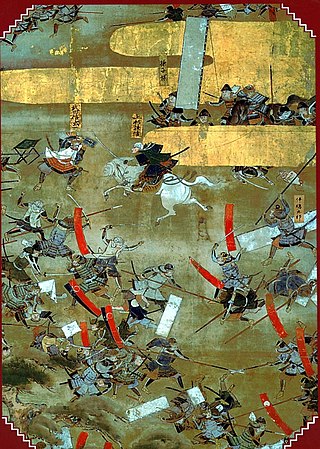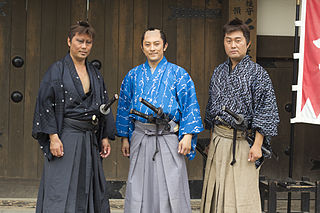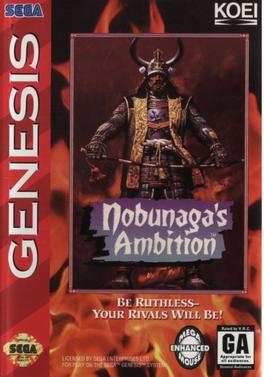
Oda Nobunaga was a Japanese daimyō and one of the leading figures of the Sengoku and Azuchi-Momoyama periods. He was the Tenka-bito and regarded as the first "Great Unifier" of Japan. Sometimes referred as the "Demon Daimyō" and "Demon King of the Sixth Heaven".

Samurai were soldiers who served as retainers to lords in Feudal Japan. Samurai existed from the late 12th century until their abolition in the late 1870s during the Meiji era.

Shogun, officially sei-i taishōgun, was the title of the military rulers of Japan during most of the period spanning from 1185 to 1868. Nominally appointed by the Emperor, shoguns were usually the de facto rulers of the country, except during parts of the Kamakura period and Sengoku period when the shoguns themselves were figureheads, with real power in the hands of the shikken (執権) of the Hōjō clan and kanrei (管領) of the Hosokawa clan. In addition, Taira no Kiyomori and Toyotomi Hideyoshi were leaders of the warrior class who did not hold the position of shogun, the highest office of the warrior class, yet gained the positions of daijō-daijin and kampaku, the highest offices of the aristocratic class. As such, they ran their governments as its de facto rulers.

The Sengoku period, also known as Sengoku Jidai, is the period in Japanese history in which civil wars and social upheavals took place almost continuously in the 15th and 16th centuries. The Kyōtoku incident (1454), Ōnin War (1467), or Meiō incident (1493) is generally chosen as the period's start date, but there are many competing historiographies for its end date, ranging from 1568, the date of Oda Nobunaga's march on Kyoto, to the suppression of the Shimabara Rebellion in 1638, deep into what is traditionally considered the Edo period. Regardless of the dates chosen, the Sengoku period overlaps substantially with the Muromachi period (1336–1573).

Matsunaga Danjō Hisahide was a daimyō and head of the Yamato Matsunaga clan in Japan during the Sengoku period of the 16th century.

MicroProse is an American video game publisher and developer founded by Bill Stealey, Sid Meier, and Andy Hollis in 1982. It developed and published numerous games, including starting the Civilization and X-COM series. Most of their internally developed titles were vehicle simulation and strategy games.

Takeda Shingen was daimyo of Kai Province during the Sengoku period of Japan. Known as the "Tiger of Kai", he was one of the most powerful daimyo of the late Sengoku period, and credited with exceptional military prestige. Shingen was based in a poor area with little arable land and no access to the sea, but he became one of Japan's leading daimyo. His skills are highly esteemed and on par with Mōri Motonari.

Azai Nagamasa was a Japanese daimyō of the Sengoku period known as the brother-in-law and enemy of Oda Nobunaga. Nagamasa was head of the Azai clan seated at Odani Castle in northern Ōmi Province and married Nobunaga's sister Oichi in 1564, fathering her three daughters – Yodo-dono, Ohatsu, and Oeyo – who became prominent figures in their own right.

Silent Service is a submarine simulator video game designed by Sid Meier and published by MicroProse for various 8-bit home computers in 1985 and for 16-bit systems like the Amiga in 1987. A Nintendo Entertainment System version developed by Rare was published in 1989 by Konami in Europe and by Konami's Ultra Games subsidiary in North America. Silent Service II was released in 1990. Tommo purchased the rights to this game and published it online through its Retroism brand in 2015.

Silent Service II is a submarine simulation game developed and published by MicroProse for MS-DOS in 1990 and for the Amiga in 1991. It is a sequel to 1985's Silent Service, also set in the Pacific Ocean during World War II. Tommo purchased the rights to this game and digitally publishes it through its Retroism brand in 2015.

Sid Meier's Pirates! is a video game created by Sid Meier for the Commodore 64 and published by MicroProse in May 1987. It was the first game to include the name "Sid Meier" in its title as an effort by MicroProse to attract fans of Meier's earlier games, most of which were combat vehicle simulation video games. The game is a simulation of the life of a pirate, a privateer, or a pirate hunter in the 16th, 17th and 18th centuries. It was widely ported to other systems.

Shogun: Total War is a turn-based strategy and real-time tactics video game developed by The Creative Assembly and published by Electronic Arts for Microsoft Windows personal computers. Released in June 2000, the game became the debut title in The Creative Assembly's Total War series. Set in Japan during Sengoku jidai—the "Warring States" period from the 15th to the beginning of the 17th century—the game has players adopt the leader of a contemporary Japanese clan, attempt to conquer the nation and claim the position of shōgun. The turn-based aspect of the game focuses on a map of Japan where military force, religion, diplomacy, espionage and economics all influence the player's actions, whilst battles are fought in a 3D real-time mode.

Jidaigeki is a genre of film, television, video game, and theatre in Japan. Literally meaning "period dramas", it refers to stories that take place before the Meiji Restoration of 1868.

Gunship is a combat flight simulation video game developed and published by MicroProse in 1986. In the game, controlling a simulated AH-64 Apache helicopter, players navigate through missions to attack enemy targets and protect friendly forces. Commercially and critically successful, Gunship was followed by Gunship 2000 and Gunship!.

Nobunaga's Ambition is a series of turn-based grand strategy role-playing simulation video games. The original game was one of the first in its genre, being released in March 1983 by the Japanese video game developer Koei. Nobunaga's Ambition takes place during the Sengoku period of feudal Japan. The player is tasked with achieving the ultimate goal of warlord Oda Nobunaga: the conquest and unification of Japan. Selecting Oda Nobunaga is optional, however, as the player is also able to choose from a variety of other regional daimyōs of the time.

F-15 Strike Eagle is an F-15 Strike Eagle combat flight simulation game released for Atari 8-bit computers in 1984 by MicroProse then ported to other systems. It is the first in the F-15 Strike Eagle series followed by F-15 Strike Eagle II and F-15 Strike Eagle III. An arcade version of the game was released simply as F-15 Strike Eagle in 1991, which uses higher-end hardware than was available in home systems, including the TMS34010 graphics-oriented CPU.
Many significant Japanese historical people of the Sengoku period appear in works of popular culture such as anime, manga, and video games. This article presents information on references to several historical people in such works.

Star Command is a video game released by Strategic Simulations in 1988.

Nobunaga's Ambition is a 1986 strategy game by Koei, focused in the Sengoku period of the history of Japan. A part of Koei's "Historical Simulation" line of titles, it was published on several platforms such as IBM PC compatibles, Amiga, the Nintendo Entertainment System, Super NES, and Mega-Drive. It is the second game in the Nobunaga's Ambition series and the first Nobunaga's Ambition title to be released in English. The player has the objective unifying Japan as Oda Nobunaga or as any of the other daimyos present in the game. Several revisions were made to the gameplay since the first game, as well as a 50-province mode which expanded the game's map to feature all of Japan.

Chronicles of Osgorth: The Shattered Alliance is a 1981 computer wargame published by Strategic Simulations in January 1982 for the Apple II and Atari 8-bit computers. Programmed by John Lyon, it relies on a new game engine, called RapidFire, intended to make faster and easier access to wargames published by the studio. During a turn, the program selects the units each in turn and the player only has to order them to move, attack or cast a spell. The order is then executed immediately before the program selects another unit. The game offers two categories of scenarios. The first is composed of medieval-fantasy confrontation, including a free adaptation of the Battle of Gondor against the Mordor forces in the Lord of the Rings. The second is composed of historical battles of antiquity.



















